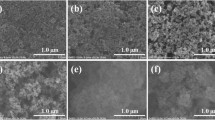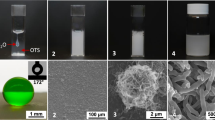Abstract
Siloxane/oxide hybrids have attracted growing attention thanks to their ability to modulate the surface energy, wettability, or self-lubricity of a material. Here, we compare two functionalisation procedures (chemical vapour deposition and wet impregnation) on substrate films composed by preformed oxide particles. Three kinds of particles, characterised by different natures (SiO2 and TiO2) and average particle size, were studied to highlight possible effects related to the chemical and morphological state of the substrate surface. Morphological characterisations were carried out using dynamic light scattering and scanning electron microscopy, while the structure of the hydrophobing layer was studied by combining Fourier transform infrared spectroscopy and solid-state nuclear magnetic resonance. The degree of functionalisation and the features of the siloxane layer vary significantly among the adopted oxides and functionalisation methods. The wettability features of the different hybrids closely mirror the results of the spectroscopic characterisations, giving rise to either Lotus leaf or patch-wise hydrophobic systems depending on the adopted conditions.






Similar content being viewed by others
References
Yao X, Song YL, Jiang L (2011) Applications of bio-inspired special wettable surfaces. Adv Mater 23:719–734
Spori DM, Drobek T, Zurcher S, Ochsner M, Sprecher C, Muehlebach A, Spencer ND (2008) Beyond the lotus effect: roughness, influences on wetting over a wide surface-energy range. Langmuir 24:5411–5417
Spori DM, Venkataraman NV, Tosatti SGP, Durmaz F, Spencer ND, Zurcher S (2007) Influence of alkyl chain length on phosphate self-assembled monolayers. Langmuir 23:8053–8060
Meroni D, Ardizzone S, Cappelletti G, Ceotto M, Ratti M, Annunziata R, Benaglia M, Raimondi L (2011) Interplay between chemistry and texture in hydrophobic TiO2 hybrids. J Phys Chem C 115:18649–18658
Quere D (2008) Wetting and roughness. Annu Rev Mater Res 38:71–99
Sagiv J (1980) Organized monolayers by adsorption. 1. Formation and structure of oleophobic mixed monolayers on solid surfaces. J Am Chem Soc 102:92–98
Meroni D, Ardizzone S, Schubert US, Hoeppener S (2012) Probe-based electro-oxidative lithography of OTS SAMs deposited onto transparent ITO substrates. Adv Funct Mater 22:4376–4382
Hozumi A, Ushiyama K, Sugimura H, Takai O (1999) Fluoroalkylsilane monolayers formed by chemical vapour surface modification on hydroxylated oxide surfaces. Langmuir 15:7600–7604
Zhang F, Sautter K, Larsen AM, Findley DA, Davis RC, Samha H, Linford MR (2010) Chemical vapour deposition of three aminosilanes on silicon dioxide: surface characterization, stability, effects of silane concentration, and cyanine dye adsorption. Langmuir 26:14648–14654
Zhu MJ, Lerum MZ, Chen W (2012) How to prepare reproducible, homogeneous, and hydrolytically stable aminosilane-derived layers on silica. Langmuir 28:416–423
Onclin S, Ravoo BJ, Reinhoudt DN (2005) Engineering silicon oxide surfaces using self-assembled monolayers. Angew Chem Int Ed 44:6282–6304
Koga T, Morita M, Ishida H, Yakabe H, Sasaki S, Sakata O, Otsuka H, Takahara A (2005) Dependence of the molecular aggregation state of octadecylsiloxane monolayers on preparation methods. Langmuir 21:905–910
Bravo J, Zhai L, Wu ZZ, Cohen RE, Rubner MF (2007) Transparent superhydrophobic films based on silica nanoparticles. Langmuir 23:7293–7298
Maino G, Meroni D, Pifferi V, Falciola L, Soliveri G, Cappelletti G, Ardizzone S (2013) Electrochemically assisted deposition of transparent, mechanically robust TiO2 films for advanced applications. J Nanopart Res. 15:2087. doi:10.1007/s11051-013-2087-2
Meroni D, Ardizzone S, Cappelletti G, Oliva C, Ceotto M, Poelman D, Poelman H (2011) Photocatalytic removal of ethanol and acetaldehyde by N-promoted TiO2 films: the role of the different nitrogen sources. Catal Today 161:169–174
Paz YR (2011) Self-assembled monolayers and titanium dioxide: from surface patterning to potential applications. Beilstein J Nanotech 2:845–861
JCPDS-ICDD card no. 21-1272 (2002) International Centre for Diffraction Data. ICCD, Newtown Square
Cappelletti G, Ardizzone S, Meroni D, Soliveri G, Ceotto M, Biaggi C, Benaglia M, Raimondi L (2013) Wettability of bare and fluorinated silanes: a combined approach based on surface free energy evaluations and dipole moment calculations. J Colloid Interf Sci 389:284–291
Milanesi F, Cappelletti G, Annunziata R, Bianchi CL, Meroni D, Ardizzone S (2010) Siloxane-TiO2 hybrid nanocomposites. The structure of the hydrophobic layer. J Phys Chem C 114:8287–8293
Soliveri G, Annunziata R, Ardizzone S, Cappelletti G, Meroni D (2012) Multiscale rough titania films with patterned hydrophobic/oleophobic features. J Phys Chem C 116:26405–26413
Puglisi A, Annunziata R, Benaglia M, Cozzi F, Gervasini A, Bertacche V, Sala MC (2009) Hybrid inorganic–organic materials carrying tertiary amine and thiourea Residues tethered on mesoporous silica nanoparticles: synthesis, characterization, and co-operative catalysis. Adv Synth Catal 351:219–229
Legrand A (1998) The surface properties of silicas. John Wiley, New York
Monterra C (1988) An infrared spectroscopic study of anatase properties.6. Surface hydration and strong lewis acidity of pure and sulfate-doped preparations. J Chem Soc Farad Trans 1:1617–1637
Bellamy L (1968) Advances in infra-red group frequencies. Methuen, London
Vallant T, Kattner J, Brunner H, Mayer U, Hoffmann H (1999) Investigation of the formation and structure of self-assembled alkylsiloxane monolayers on silicon using in situ attenuated total reflection infrared spectroscopy. Langmuir 15:5339–5346
Chang HY, Thangamuthu R, Lin CW (2004) Structure-property relationships in PEG/SiO2 based proton conducting hybrid membranes—a Si-29 CP/MAS solid-state NMR study. J Membrane Sci 228:217–226
Brodard-Severac F, Guerrero G, Maquet J, Florian P, Gervais C, Mutin PH (2008) High-field O-17 MAS NMR investigation of phosphonic acid monolayers on titania. Chem Mater 20:5191–5196
Huh S, Chen HT, Wiench JW, Pruski M, Lin VSY (2005) Cooperative catalysis by general acid and base bifunctionalized mesoporous silica nanospheres. Angew Chem Int Ed 44:1826–1830
Kovacek D, Maksic ZB, Elbel S, Kudnig J (1994) Semiempirical calculation of Si-29 NMR chemical-shifts and Si-29-C-13 Spin–spin coupling-constants in some substituted bridgehead polycycloalkanes. J Mol Struct-Theochem 110:247–254
Huh S, Wiench JW, Yoo JC, Pruski M, Lin VSY (2003) Organic functionalization and morphology control of mesoporous silicas via a co-condensation synthesis method. Chem Mater 15:4247–4256
Kujawa J, Kujawski W, Koter S, Rozicka A, Cerneaux S, Persin M, Larbot A (2013) Efficiency of grafting of Al2O3, TiO2 and ZrO2 powders by perfluoroalkylsilanes. Colloid Surf A 420:64–73
Moriguchi T, Murase K, Sugimura H (2008) Ruthenium-amine complexation for constructing self-assembled molecular films. Colloid Surf A 321:94–98
Sugimura H, Moriguchi T, Kanda M, Sonobayashi Y, Nishimura HM, Ichii T, Murase K, Kazama S (2011) Molecular packing density of a self-assembled monolayer formed from N-(2-aminoethyl)-3-aminopropyltriethoxysilane by a vapor phase process. Chem Commun 47:8841–8843
Wenzel R (1936) Resistance of solid surfaces to wetting by water. Ind Eng Chem 28:988–994
Cassie AB (1944) Wettability of porous surfaces. Trans Farad Soc 40:546–551
Nosonovsky M, Bhushan B (2009) Superhydrophobic surfaces and emerging applications: non-adhesion, energy, green engineering. Curr Opin Colloid Interface Sci 14:270–280
Kim WJ, Kim S, Lee BS, Kim A, Ah CS, Huh C, Sung GY, Yun WS (2009) Enhanced protein immobilization efficiency on a TiO2 surface modified with a hydroxyl functional group. Langmuir 25:11692–11697
Acknowledgements
This research has been supported by the University of Milan Research Funds (PUR).
Author information
Authors and Affiliations
Corresponding author
Electronic supplementary material
Below is the link to the electronic supplementary material.
10853_2013_7976_MOESM1_ESM.pdf
Online Resources: Assignments of 13C NMR resonanes; Fitting analysis of the 29Si NMR spectra of siloxane–TiO2 composites obtained using WI and CVD, and sketches of the structures attributed to the different resonances; Static contact angles for different solvents on the functionalised oxide samples
Rights and permissions
About this article
Cite this article
Soliveri, G., Meroni, D., Cappelletti, G. et al. Engineered organic/inorganic hybrids for superhydrophobic coatings by wet and vapour procedures. J Mater Sci 49, 2734–2744 (2014). https://doi.org/10.1007/s10853-013-7976-3
Received:
Accepted:
Published:
Issue Date:
DOI: https://doi.org/10.1007/s10853-013-7976-3




